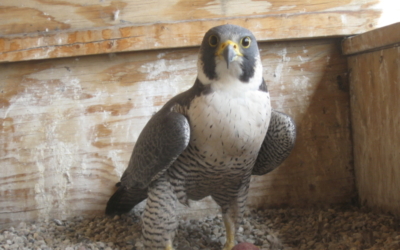Swap Your Lawn Mower for a Goat: The Benefits of Grazing
For corporate landowners, vegetation maintenance is a near-constant need. It can be time-consuming, costly and environmentally harmful to maintain the grass and vegetation at a corporate facility. Depending on the acreage of the site and the frequency of mowing, professional lawn care services can cost anywhere from $150 to upwards of $700 — and even for a company that has an in-house maintenance staff, lawn care can amount to weeks of work that could be better spent elsewhere.
Traditional lawn and vegetation maintenance often require the use of gas-powered tools that emit greenhouse gases as well as particulate matter that can negatively impact human health. According to the EPA, one gas lawn mower emits 89 pounds of CO₂ each year, and refueling gas-powered lawn equipment results in 17 million gallons of spilled gasoline a year. Fortunately, there is a method of vegetation maintenance that is more environmentally friendly: grazing animals.
While goats have been used to manage vegetation for more than a century, many herbivores can graze in vegetated areas, including sheep, cattle, horses, deer and even donkeys. In addition to routine grazing on grassy areas, goats or other grazing animals can also clear out brush in forested areas and even remove invasive species in locations that may be difficult for people and machinery to access.
Providing grazing land for animals has numerous benefits for both the environment and the company, such as:
Improved ecological health
Grazing improves soil health by cycling carbon and other nutrients back into the soil while also reducing water runoff and sediment erosion and sequestering carbon. In addition, grazing cuts down on the amount of fertilizer and herbicides needed to maintain the vegetation in an area.
Another key added benefit of grazing animals is the boost in biodiversity. Using sheep for grazing can increase the biodiversity of an area by up to 40%, since their manure adds nutrients to the soil and attracts other insects and animals. While they’re grazing on one source of food, animals will inevitably trample on other plants, which makes it more difficult for any one plant species to dominate the area.
Wildfire mitigation
With wildfires increasing in frequency and intensity due to climate change, a top benefit of grazing animals is the reduction of flammable vegetation in forested areas. In areas that have a high risk of wildfires, animals like goats can cut down on grasses and brush that could potentially fuel a catastrophic fire. In fact, firefighters were able to quickly contain a recent wildfire in California because a herd of grazing goats and sheep had cleared out much of the fuel. The organic matter introduced to the soil by animal manure also helps it absorb more water, which can prevent wildfires from igniting in the first place.
Pollution reduction
Using grazing animals, even occasionally, decreases a company’s use of lawn equipment powered by fossil fuels. Not only does this help reduce CO₂ emissions, but it also creates less fine particulate matter in the air, which can be harmful to maintenance workers’ health.
In addition to air pollution, mowers, trimmers and leaf blowers generate noise pollution, which can disturb people and animals living nearby. The sound of a gas-powered mower or trimmer can reach up to 85 decibels, which can cause hearing damage. Grazing animals are much quieter, especially in residential or populated areas. You may hear occasional vocalizations from them, but that only adds to the charm!
Economic savings and growth
In terms of saving time and money, using grazing animals reduces a company’s need to pay for outside lawn management services or to fuel and maintain their own equipment. Grazing animals are also often more efficient than human workers – for example, a herd of 60 goats can clear one acre of vegetation in just a few days.
While they’re saving time and money, companies also have the opportunity to invest in their community either by partnering with local farms and ranchers or by purchasing the services of a local goat rental company.
Community education
Seeing goats or sheep outside of a farm or petting zoo is novel and often grabs people’s attention. Having grazing animals on corporate land presents an opportunity for the company to teach the community about the animals as well as the benefits of grazing and any other conservation projects they’ve undertaken. Community events, school visits, social media posts and press releases are great tactics to help spread the word when you’re using grazing animals for vegetation management.
Considerations
As the benefits have shown, deciding to bring grazing animals into your grassland or corporate lawn is a positive step for the biodiversity of the area as well as your company. But there are a few considerations you should take into account if you want to use grazing animals to maintain your site:
- Make sure there’s a way to keep the animals in the intended grazing area. A temporary, portable fence is usually sufficient.
- Match the nutritional needs of the animal to the vegetation at your site. Goats in particular will eat just about anything, but it’s important to make sure that nothing in the area will be toxic or poisonous to the grazing animals.
- Determine how often you will need to graze and how many animals will be needed.
With these considerations, grazing animals can be a beneficial and interesting new way to maintain the vegetation at your corporate site.



